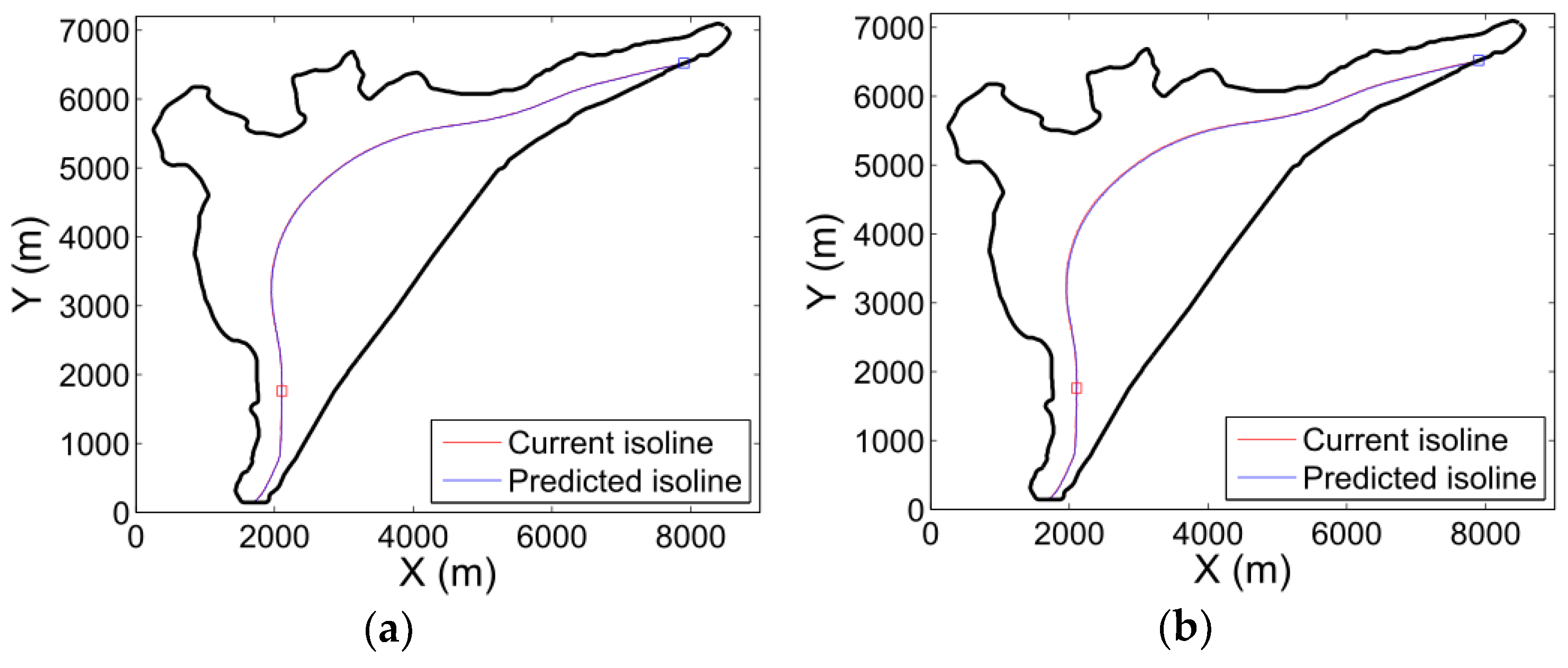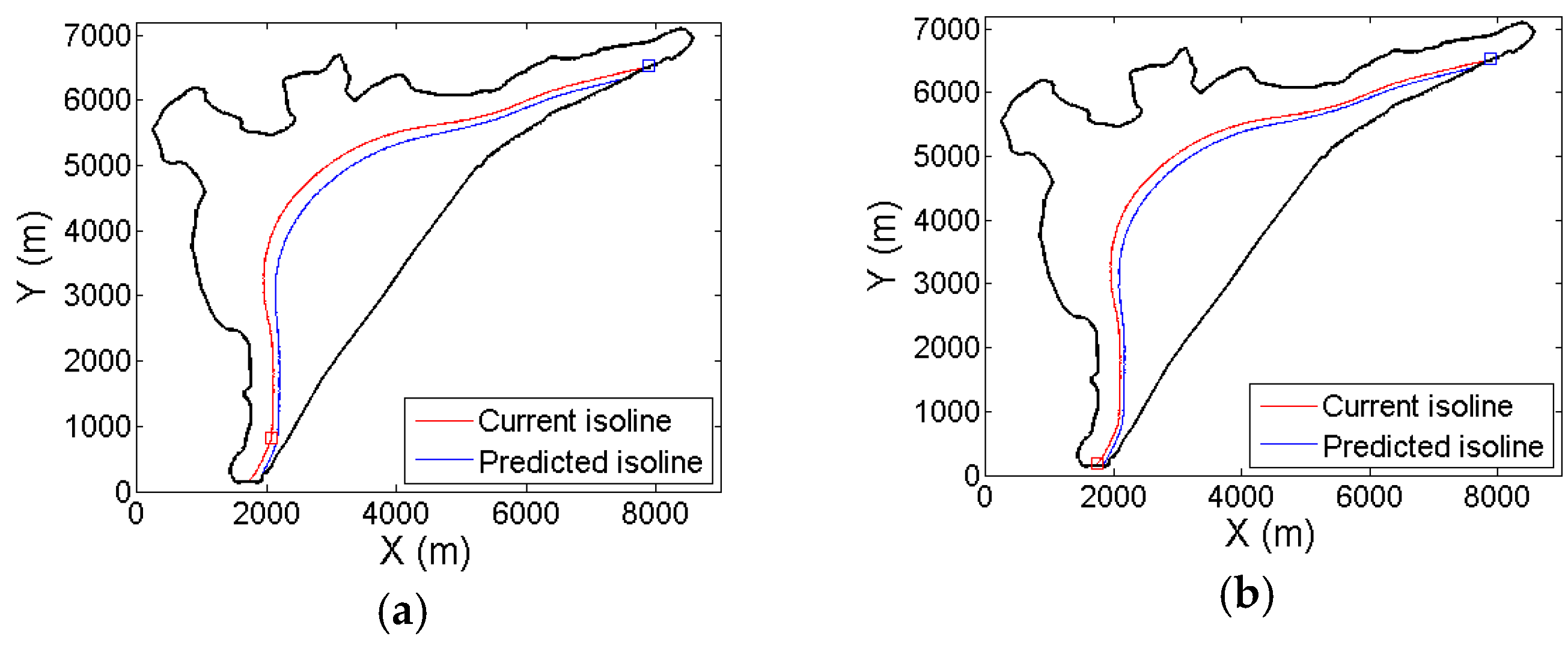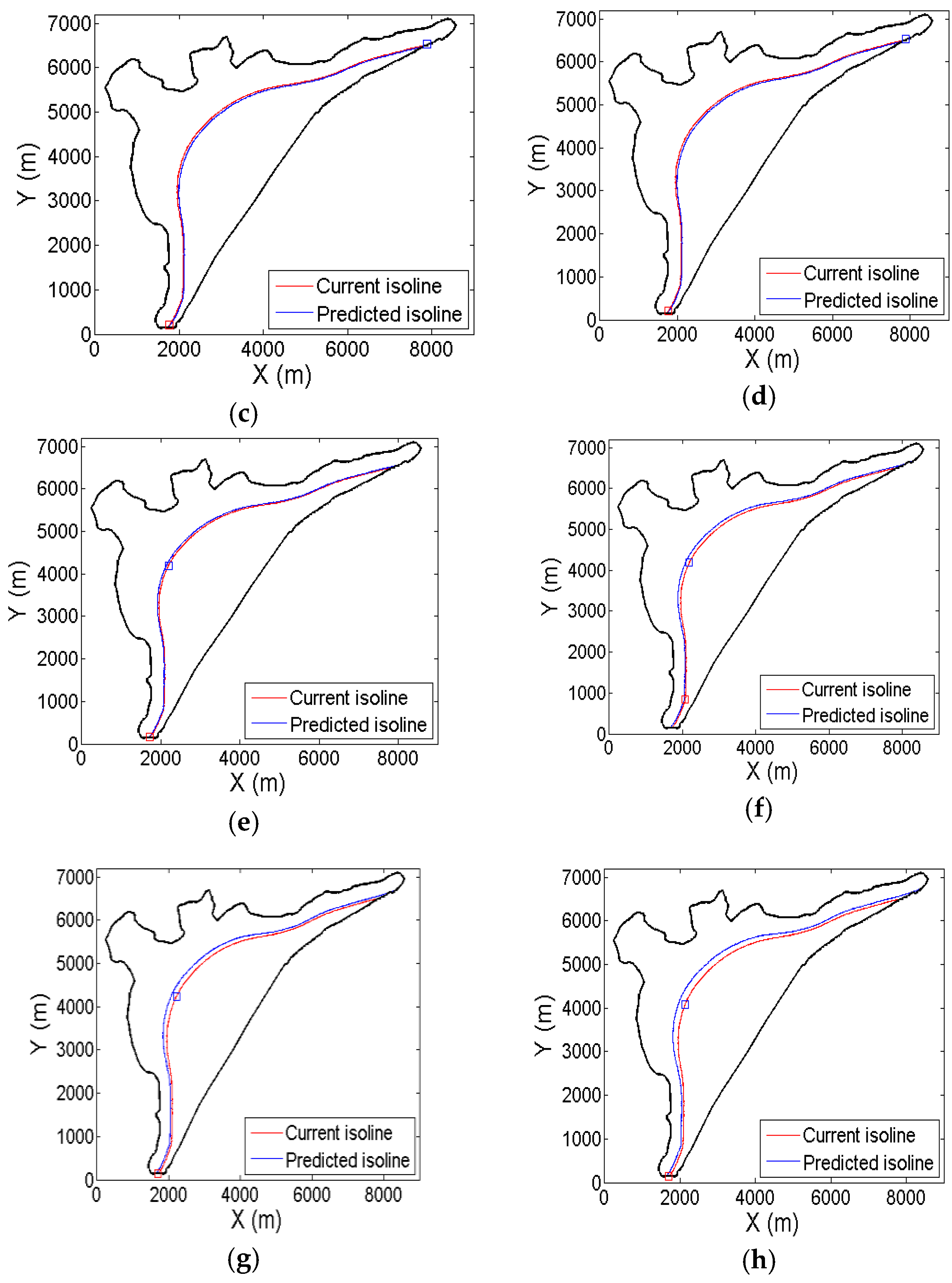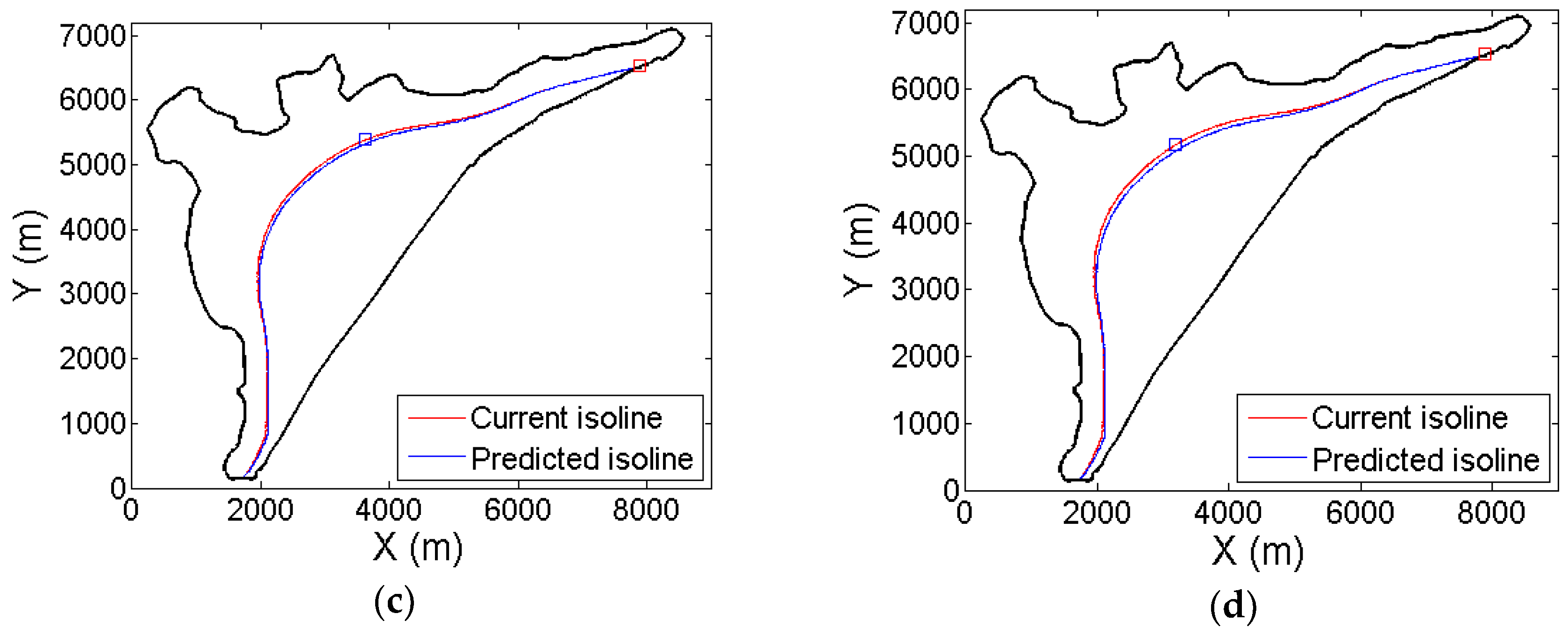Assessing the Contribution of Demographic Growth, Climate Change, and the Refugee Crisis on Seawater Intrusion in the Tripoli Aquifer
Abstract
:1. Introduction
2. Materials and Methods
2.1. The Tripoli Aquifer Characterization
2.2. Mathematical and Numerical Model
2.3. Global Change Processes and Model Configuration
- The sea level: The sea level has been estimated to raise, on average, by 10–20 cm in the last century [5]. Based on [25], the decrease in atmospheric pressure is the main reason for sea level rise. The snow and ice melt, and the temperature elevation will impact the studied zone. The sensitivity study was implemented for four levels of sea rise: (a) 50 cm, (b) 100 cm, (c) 150 cm, and (d) 200 cm. This change affects the parameter h0 in the model. By changing this parameter in Equation (5), the impact of the sea level rise is considered. The impact on the shoreline is not considered here.
- The groundwater recharge: The groundwater recharge is also subject to climate change. The impact of climate change on the groundwater recharge has been assessed in [15]. The forecasts show a huge global variability in the groundwater recharge. For example, the recharge is expected to increase in some regions in the north of Brazil to about 70% from 2008 to 2050. On the other hand, the recharge is expected to decrease to about 30% in the north of China for the same period. This variability will induce floods in some regions while causing coastal aquifers salinization in others. The aquifer recharge is expressed via the incoming flux from precipitation and snow melt. Because the incoming flux can increase in some years and decrease in other depending on the quantity of snow melt in each year, the change of the incoming flux is calculated by multiplying it by a coefficient of 0.8 up to 1.2 with a step of 0.05.
- The extraction rate: According to the United Nations Environment program (UNEP), 75% of the global population will be living in coastal areas by 2020. This will increase the need for freshwater in these zones, and because the main portion of the available freshwater is underground water, the extraction rate will increase in coming years. The extraction rates depend on the economic activities in the area. In the case of the Tripoli aquifer, the main use is domestic. As presented in the site description, a rate of 250 liters/capita/day for all combined activities is considered.
2.4. Evaluation Criterion
3. Results
3.1. Sensitivity Analysis
3.1.1. Impact of Sea Level Rise
3.1.2. Impact of Inflow Freshwater Flux
3.1.3. Impact of the Extraction Rate
3.2. Impact of Future Scenarios
3.2.1. Impact of Projected Sea Level Rise
3.2.2. Impact of Climate Trends on Recharge
3.2.3. Impact of Demographic Growth
3.2.4. Impact of Syrian Refugee Crisis
3.3. Contribution of Each Projection to Global Change
4. Discussion
5. Conclusions
Author Contributions
Funding
Acknowledgments
Conflicts of Interest
References
- Rodell, M.; Famiglietti, J.S.; Wiese, D.N.; Reager, J.T.; Beaudoing, H.K.; Landerer, F.W.; Lo, M.H. Emerging trends in global freshwater availability. Nature 2018. [Google Scholar] [CrossRef] [PubMed]
- European Environment Agency. Water Resources in Europe in the Context of Vulnerability: EEA 2012 State of Water Assessment; EEA Report No. 11/2012; European Environment Agency: Copenhagen, Denmark, 2012. [Google Scholar]
- Ferguson, G.; Gleeson, T. Vulnerability of coastal aquifers to groundwater use and climate change. Nat. Clim. Chang. 2012, 2, 342–345. [Google Scholar] [CrossRef]
- Chang, S.W.; Clement, T.P.; Simpson, M.J.; Lee, K.K. Does sea-level rise have an impact on saltwater intrusion? Adv. Water Resour. 2011, 34, 1283–1291. [Google Scholar] [CrossRef] [Green Version]
- Sherif, M.M.; Singh, V.P. Effect of climate change on sea water intrusion in coastal aquifers. Hydrol. Process. 1999, 13, 1277–1287. [Google Scholar] [CrossRef]
- Kerrou, J.; Renard, P.; Cornaton, F.; Perrochet, P. Stochastic forecasts of seawater intrusion towards sustainable groundwater management: Application to the Korba aquifer (Tunisia). Hydrogeol. J. 2013, 21, 425–440. [Google Scholar] [CrossRef]
- Guyennon, N.; Salerno, F.; Portoghese, I.; Romano, E. Climate change adaptation in a Mediterranean semi-arid catchment: Testing managed aquifer recharge and increased surface reservoir capacity. Water 2017, 9, 689. [Google Scholar] [CrossRef]
- Lababidi, H.; Shatila, A.; Acra, A. The progressive salination of groundwater in Beirut, Lebanon. Int. J. Environ. Stud. 1987, 30, 203–208. [Google Scholar] [CrossRef]
- Moujabber, M.E.; Samra, B.B.; Darwish, T.; Atallah, T. Comparison of Different Indicators for Groundwater Contamination by Seawater Intrusion on the Lebanese Coast. Water Resour. Manag. 2006, 20, 161–180. [Google Scholar] [CrossRef]
- Korfali, S.I.; Jurdi, M. Assessment of domestic water quality: Case study, Beirut, Lebanon. Environ. Monit. Assess. 2007, 135, 241–251. [Google Scholar] [CrossRef] [PubMed]
- Halwani, J.; Omar, W.; Alkadi, F. Intrusion Saline à Tripoli; Internal Report; Lebanese University: Tripoli, Lebanon, 2010. [Google Scholar]
- Kalaoun, O.; Al Bitar, A.; Gastellu-Etchegorry, J.P.; Jazar, M. Impact of Demographic Growth on Seawater Intrusion: Case of the Tripoli Aquifer, Lebanon. Water 2016, 8, 104. [Google Scholar] [CrossRef]
- Bear, J. Hydraulics of Groundwater; Mc Grraw-Hill: Mineola, NY, USA, 1979. [Google Scholar]
- Jazar, M.; Monneau, R. Derivation of seawater intrusion models by formal asymptotics. SIAM J. Appl. Math. 2014, 74, 1152–1173. [Google Scholar] [CrossRef]
- Bates, B.; Kundzewicz, Z.W.; Wu, S.; Palutikof, J. Climate Change and Water; Intergovernmental Panel on Climate Chang (IPCC): Geneva, Switzerland, 2008. [Google Scholar]
- Haramadiyan, D. Report to the Municipality of Tripoli; Tripoli Municipality: Tripoli, Lebanon, 2004. [Google Scholar]
- Amin, I.E. Groundwater mining in the Tripoli area, Lebanon. In Proceedings of the Denver Annual Meeting, Denver, CO, USA, 27–30 October 2002. [Google Scholar]
- Khair, K.; Khawlie, M.; Haddad, F.; Barazangi, M.; Seber, D.; Chaimov, T. Bouguer gravity and crustal structure of the Dead Sea transform fault and adjacent mountain belts in Lebanon. Geology 1993, 21, 739–742. [Google Scholar] [Green Version]
- Diersch, H.J.; Kolditz, O. Variable-density flow and transport in porous media: Approaches and challenges. Adv. Water Resour. 2002, 25, 899–944. [Google Scholar] [CrossRef]
- Najib, K.; Rosier, C. On the global existence for a degenerate elliptic-parabolic seawater intrusion problem. Math. Comput. Simul. 2011, 81, 2282–2295. [Google Scholar] [CrossRef]
- Choquet, C.; Diédhiou, M.M.; Rosier, C. Mathematical analysis of a sharp–diffuse interfaces model for seawater intrusion. J. Differ. Equat. 2015, 259, 3803–3824. [Google Scholar] [CrossRef]
- Alkhayal, J.; Issa, S.; Jazar, M.; Monneau, R. Existence result for degenerate cross-diffusion system with application to seawater intrusion. ESAIM COCV 2017. [Google Scholar] [CrossRef]
- Hecht, F. New development in FreeFem++. J. Numer. Math. 2012, 20, 251–265. [Google Scholar] [CrossRef]
- Bakker, M.; Strack, O. Analytic elements for multi aquifer flow. J. Hydrol. 2003, 271, 119–129. [Google Scholar] [CrossRef]
- Theon, J.S. Global warming and environmental changes on the surface of the earth. In Proceedings of the Memorial Seminar of the Silver Jubilee on the Occasion of the XXV IAHR Biennial Congress, Tokyo, Japan, 30 August–9 September 1993. [Google Scholar]
- Cazenave, A.; Dieng, H.B.; Meyssignac, B.; von Schuckmann, K.; Decharme, B.; Berthier, E. The rate of sea-level rise. Nat. Clim. Chang. 2014, 4, 358–361. [Google Scholar] [CrossRef]
- Dieng, H.B.; Cazenave, A.; Meyssignac, B.; Ablain, M. New estimate of the current rate of sea level rise from a sea level budget approach. Geophys. Res. Lett. 2017, 44, 3744–3751. [Google Scholar] [CrossRef]
- Field, C.B.; Barros, V.R.; Mach, K.; Mastrandrea, M. Climate Change 2014: Impacts, Adaptation, and Vulnerability, 1; Cambridge University Press: Cambridge, UK; New York, NY, USA, 2014. [Google Scholar]
- Khayat, Z. Assessment of the National Groundwater Resources of Lebanon; Implemented by Joint–Venture ELARD BURGEAP–IGIP and Ribeka on Behalf of the UNDP; Ministry of Energy and Water: Beirut, Lebanon, 2014.
- Chun, J.A.; Lim, C.; Kim, D.; Kim, J.S. Assessing Impacts of Climate Change and Sea-Level Rise on Seawater Intrusion in a Coastal Aquifer. Water 2018, 10, 357. [Google Scholar] [CrossRef]
- Rasmussen, P.; Sonnenborg, T.O.; Goncear, G.; Hinsby, K. Assessing impacts of climate change, sea level rise, and drainage canals on saltwater intrusion to coastal aquifer. Hydrol. Earth Syst. Sci. 2013, 17, 421–443. [Google Scholar] [CrossRef]
- Vineis, P.; Chan, Q.; Khan, A. Climate change impacts on water salinity and health. J. Epidemiol. Glob. Health 2011, 1, 5–10. [Google Scholar] [CrossRef] [PubMed]
- Tohme, R.A.; Jurjus, A.R.; Estephan, A. The prevalence of hypertension and its association with other cardiovascular disease risk factors in a representative sample of the Lebanese population. J. Hum. Hypertens. 2005, 19, 861. [Google Scholar] [CrossRef] [PubMed]















| Sea Level Rise (cm) | Minimal Advance (m) | Maximal Advance (m) |
|---|---|---|
| 50 | 1.3 | 28 |
| 100 | 2.8 | 44.8 |
| 150 | 4.2 | 76.4 |
| 200 | 5.3 | 98 |
| Rate Change of Flux | Minimal Advance (m) | Maximal Advance (m) |
|---|---|---|
| −20% | 80 | 230 |
| −15% | 50 | 165 |
| −10% | 29 | 105 |
| −5% | 9 | 50 |
| +5% | 15 | 65 |
| +10% | 20 | 90 |
| +15% | 36 | 130 |
| +20% | 50 | 160 |
| Multiplicative Coefficient | Median Advancement (m) |
|---|---|
| 1.25 | 13 |
| 1.5 | 17 |
| 1.75 | 26 |
| 2 | 35 |
| Year | Number of Inhabitants without Considering the Migration | Number of İnhabitants Considering the Migration |
|---|---|---|
| 2013 | 87,500 | 127,500 |
| 2018 | 95,000 | 145,000 |
| 2023 | 102,500 | 156,500 |
| 2028 | 110,000 | 167,000 |
| 2033 | 120,000 | 180,000 |
| Year | Without Refugees | With Refugees | ||
|---|---|---|---|---|
| Maximal Advance | Median Advance | Maximal Advance | Median Advance | |
| 2013 | 14 | 2.5 | 50 | 15 |
| 2018 | 20 | 5.5 | 64 | 24 |
| 2023 | 26 | 8.5 | 75 | 32 |
| 2028 | 32 | 12 | 87 | 37 |
| 2033 | 41 | 16 | 102 | 43 |
| Year | Sea Rise | Change of Inflow | Extraction Rate | Total | |||
|---|---|---|---|---|---|---|---|
| m | % | m | % | m | % | m | |
| 2013 | 0.10 | 0.7% | 10 | 79.3% | 2.50 | 19.8% | 12.60 |
| 2018 | 0.25 | 0.9% | 22 | 79.2% | 5.50 | 19.8% | 27.75 |
| 2023 | 0.45 | 1.1% | 31 | 77.5% | 8.50 | 21.2% | 39.95 |
| 2028 | 0.63 | 1.1% | 43 | 77.2% | 12.00 | 21.5% | 55.63 |
| 2033 | 0.75 | 1% | 54 | 76.3% | 16.00 | 22.6% | 70.75 |
| Year | Sea Rise | Change of Inflow | Extraction Rate | Total | |||
|---|---|---|---|---|---|---|---|
| m | % | m | % | m | % | m | |
| 2013 | 0.10 | 0.3% | 10.00 | 39.8% | 15.00 | 59.7% | 25.10 |
| 2018 | 0.25 | 0.5% | 22.00 | 48.6% | 24.00 | 53% | 46.25 |
| 2023 | 0.45 | 0.7% | 31.00 | 48.8% | 32.00 | 50.4% | 63.45 |
| 2028 | 0.63 | 0.7% | 43.00 | 52% | 37.00 | 44.7% | 80.63 |
| 2033 | 0.75 | 0.7% | 59.00 | 57% | 43.00 | 42.1% | 102.75 |
© 2018 by the authors. Licensee MDPI, Basel, Switzerland. This article is an open access article distributed under the terms and conditions of the Creative Commons Attribution (CC BY) license (http://creativecommons.org/licenses/by/4.0/).
Share and Cite
Kalaoun, O.; Jazar, M.; Al Bitar, A. Assessing the Contribution of Demographic Growth, Climate Change, and the Refugee Crisis on Seawater Intrusion in the Tripoli Aquifer. Water 2018, 10, 973. https://doi.org/10.3390/w10080973
Kalaoun O, Jazar M, Al Bitar A. Assessing the Contribution of Demographic Growth, Climate Change, and the Refugee Crisis on Seawater Intrusion in the Tripoli Aquifer. Water. 2018; 10(8):973. https://doi.org/10.3390/w10080973
Chicago/Turabian StyleKalaoun, Omar, Mustapha Jazar, and Ahmad Al Bitar. 2018. "Assessing the Contribution of Demographic Growth, Climate Change, and the Refugee Crisis on Seawater Intrusion in the Tripoli Aquifer" Water 10, no. 8: 973. https://doi.org/10.3390/w10080973





